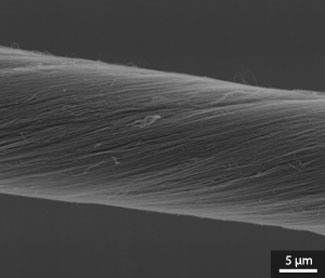| Apr 25, 2011 |
Carbon nanotube fibers containing photosensitive dyes could be applied as wearable solar cells
|
|
(Nanowerk News) Carbon nanotubes (CNTs) are amongst the most versatile materials known. They are very strong yet light-weight, and have ideal electrical conductance characteristics — properties that make them particularly interesting for applications such as flexible electronics. Bundles of CNTs also have very high surface area, which makes them of potentially great benefit for use in solar cells. Researchers from Fudan University in China have now devised a method to fabricate flexible and weavable solar cells using long fibers spun from CNTs (Flexible, Light-Weight, Ultrastrong, and Semiconductive Carbon Nanotube Fibers for a Highly Efficient Solar Cell).
|
|
"Our work provides a methodology for the fabrication of organic solar cells using high-performance CNT fibers, and possibly other one-dimensional nanostructures for novel photovoltaic devices," says Huisheng Peng from the research team.
|
 |
| Microscope image of a well-aligned CNT fiber.
|
|
Fiber-based solar cells have recently been the focus of research attention because such cells could potentially be woven into fabrics, opening up an entirely new class of applications for photovoltaics. The high strength and good electronic properties of CNTs make them ideal for such applications as they are amongst the strongest commercial yarns and can be fabricated at relatively low cost. Unfortunately, scientists have so far been unable to extract from CNTs the performance needed for useful solar energy conversion.
|
|
The researchers from Fudan University developed a method to attach organic light absorbers, called photosensitized dyes, to highly aligned CNT fibers. The dye molecules convert sunlight into electrical current, which is then carried by the CNT fiber (pictured above).
|
|
The highly uniform alignment of the nanotubes in the spun yarns ensures very efficient charge transport, making this scheme more efficient than competing designs, with many possible applications, says Peng. "This design could provide some unique applications that are unavailable to conventional solar cells, such as in aerospace applications, clothing-integrated photovoltaic devices, and power regeneration for portable electronics."
|
|
The researchers are now working to increase the solar energy conversion efficiency of the yarns beyond the 2.2% achieved in their latest study. One strategy for achieving this increase in efficiency is to attach the dye molecules more uniformly to the nanotubes, such as through better chemical bonding. The team is also investigating the use of longer nanotubes, which could further enhance the electronic properties of the fibers.
|

